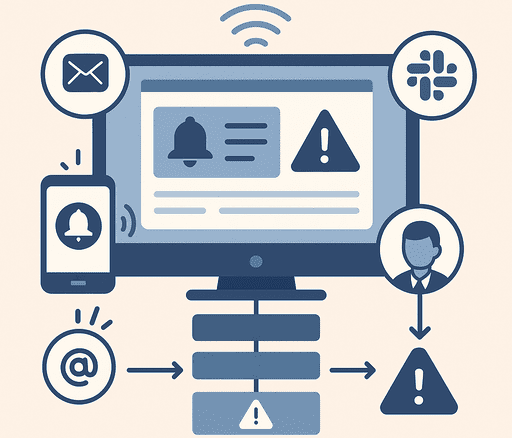Inventory Notifications & Escalation Workflows
Learn how to design effective inventory notifications and escalation workflows that keep your team informed, reduce downtime, and prevent asset loss.

Introduction
In modern inventory systems, timely communication is as important as accurate data.
When an asset goes missing, stock runs low, or maintenance is overdue, notifications and escalation workflows ensure the right people act — before issues escalate into costly problems.
Yet many organizations still rely on manual emails or static dashboards that no one checks.
This article explores how to design automated, multi-level notification systems that drive accountability and efficiency.
1. Why Notifications Matter in Inventory Management
Notifications bridge the gap between inventory data and decision-making.
Without them, even the best system can fail to trigger timely actions.
Key use cases include:
- Low-stock alerts for consumables and spare parts
- Check-in/out reminders for borrowed assets
- Overdue maintenance or calibration tasks
- Audit discrepancies or missing items
- Threshold breaches (e.g., budget, usage, or location limits)
The goal is to ensure the right person is notified at the right time — with enough context to act.
2. Core Types of Inventory Alerts
| Alert Type | Example | Delivery Method |
|---|---|---|
| Threshold Alerts | Toner levels drop below 10%. | Email, in-app |
| Event-Based Alerts | Laptop checked out but not returned. | Push, Slack/Teams |
| Periodic Alerts | Monthly audit report ready. | Email, report digest |
| Exception Alerts | Barcode scan mismatch detected. | In-app popup |
| Escalation Alerts | Unresolved issue after 24 hours. | Manager SMS or escalation ticket |
Each alert should include contextual data, not just a vague message.
For example: “Item #2035 — Dell Latitude — overdue 3 days (John D.)”.
3. Designing an Effective Escalation Workflow
An escalation workflow defines who gets notified and when, based on urgency or inaction.
A typical structure:
- Level 1 — Direct Responsible Person Initial notification (e.g., asset custodian or technician).
- Level 2 — Team Lead or Manager If no response within set time (e.g., 12 hours).
- Level 3 — Department Head / Operations If unresolved after 48 hours, marked as critical.
- Level 4 — Automated Logging Logged in system audit trail and possibly triggers external ticketing.
To avoid fatigue, always include cooldown timers, priority levels, and digest summaries to balance urgency with clarity.
4. Channel Strategy: Reaching People Where They Work
Modern teams are distributed and use various communication tools.
Multi-channel alerting ensures no task is missed.
Common integrations:
- Email — best for audit reports and documentation.
- Slack / Microsoft Teams — instant, visible, and collaborative.
- SMS / Mobile Push — for critical time-sensitive issues.
- In-app notifications — ideal for contextual updates.
- Webhook integrations — to trigger other automation tools like Jira, Asana, or ServiceNow.
Each event type should map to the most contextually appropriate channel.
5. Prioritization and Severity Levels
Every alert should have a defined priority that determines how it’s handled.
| Priority | Example | Escalation Window |
|---|---|---|
| Critical | Missing high-value asset | 2 hours |
| High | Maintenance overdue | 8 hours |
| Medium | Low stock on consumables | 24 hours |
| Low | Weekly summary reports | 72 hours |
Clearly defining severity improves visibility, reporting, and accountability.
6. Measuring Notification Effectiveness
To keep alerting under control, track:
- Response time to alerts
- Resolution rate per severity
- Number of ignored notifications
- Escalation frequency trends
- False positive rate
Continuous improvement ensures your workflows remain relevant and actionable, not noisy or ignored.
7. Automation and AI-Driven Escalations
Emerging systems apply AI-driven pattern recognition to predict when alerts are likely to escalate.
For example:
- Automatically identifying recurring offenders.
- Adjusting priority based on past incident frequency.
- Predicting asset downtime risk from repeated delays.
Such intelligence helps optimize human attention where it’s needed most.
8. Common Mistakes to Avoid
🚫 Spamming users with every minor update.
🚫 Sending identical messages across all channels.
🚫 Missing escalation timeouts.
🚫 Not linking alerts to corrective actions.
🚫 No ownership tracking in workflows.
A well-balanced notification strategy respects attention while ensuring accountability.
Conclusion
An intelligent notification and escalation system transforms inventory management from reactive to proactive.
When designed correctly, it helps your teams stay informed, act faster, and maintain accountability — all while minimizing noise.
Explore related topics: